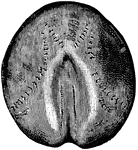The Sea Urchins and Sea Stars ClipArt gallery includes 139 illustrations of several sea star and sea urchin species. Sea stars, also called starfish, are echinoderms that are in the shape of a star, with typically five arms. Sea urchins are echinoderms that are small, spiny sea creatures shaped like a sphere or globe.
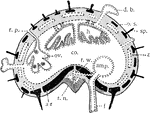
Starfish Arm Section
"Transverse section of the arm of a Starfish near the disc. Diagrammatic. Lettering as in preceding…

Starfish Nervous System
"Diagram showing arrangement of the nervous matter in Starfish. c, ganglionated ring about the mouth;…
!["Starfish is a popular name for any individual of the family Asteridæ, a familiar object on the Atlantic coasts. The body is more or less star shaped, and consists of a central portion, or disk, surrounded by five or more lobes, or arms, radiating from the body and containing prolongations of the viscera. The mouth is situated in the center of the lower surface of the body, and the anus is either absent or on the upper surface. Locomotion is effected by means of peculiar tube-like processes, which are protruded from the under surface of the arms. They possess in a high degree the power of reproducing lost members and abound in all seas. [Pictured]Common Starfish, reproducing rays"—(Charles Leonard-Stuart, 1911)](https://etc.usf.edu/clipart/16200/16277/starfish2_16277_mth.gif)
Common Starfish
"Starfish is a popular name for any individual of the family Asteridæ, a familiar object on the…
!["Starfish is a popular name for any individual of the family Asteridæ, a familiar object on the Atlantic coasts. The body is more or less star shaped, and consists of a central portion, or disk, surrounded by five or more lobes, or arms, radiating from the body and containing prolongations of the viscera. The mouth is situated in the center of the lower surface of the body, and the anus is either absent or on the upper surface. Locomotion is effected by means of peculiar tube-like processes, which are protruded from the under surface of the arms. They possess in a high degree the power of reproducing lost members and abound in all seas. [Pictured]Common Starfish (Asterias rubens)"—(Charles Leonard-Stuart, 1911)](https://etc.usf.edu/clipart/16200/16278/starfish3_16278_mth.gif)
Common Starfish
"Starfish is a popular name for any individual of the family Asteridæ, a familiar object on the…
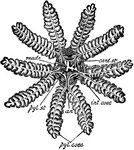
Common Starfish
"Asterias rubens. Digestive system. an, anus; card. st, cardiac division of the stomach; int. caec,…
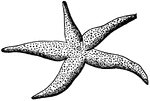
Diagram of a Starfish
A diagram of a radiata (the starfish) whose organization is much less complete than that of most other…
!["Starfish is a popular name for any individual of the family Asteridæ, a familiar object on the Atlantic coasts. The body is more or less star shaped, and consists of a central portion, or disk, surrounded by five or more lobes, or arms, radiating from the body and containing prolongations of the viscera. The mouth is situated in the center of the lower surface of the body, and the anus is either absent or on the upper surface. Locomotion is effected by means of peculiar tube-like processes, which are protruded from the under surface of the arms. They possess in a high degree the power of reproducing lost members and abound in all seas. [Pictured]Eyed Cribella (Cribella oculata)"—(Charles Leonard-Stuart, 1911)](https://etc.usf.edu/clipart/16200/16280/starfish4_16280_mth.gif)
Eyed Cribella Starfish
"Starfish is a popular name for any individual of the family Asteridæ, a familiar object on the…
!["Starfish is a popular name for any individual of the family Asteridæ, a familiar object on the Atlantic coasts. The body is more or less star shaped, and consists of a central portion, or disk, surrounded by five or more lobes, or arms, radiating from the body and containing prolongations of the viscera. The mouth is situated in the center of the lower surface of the body, and the anus is either absent or on the upper surface. Locomotion is effected by means of peculiar tube-like processes, which are protruded from the under surface of the arms. They possess in a high degree the power of reproducing lost members and abound in all seas. [Pictured] Lesser Sand-star (Ophiura albida)"—(Charles Leonard-Stuart, 1911)](https://etc.usf.edu/clipart/16200/16266/starfish1_16266_mth.gif)
Lesser Sand-Star Starfish
"Starfish is a popular name for any individual of the family Asteridæ, a familiar object on the…
!["Starfish is a popular name for any individual of the family Asteridæ, a familiar object on the Atlantic coasts. The body is more or less star shaped, and consists of a central portion, or disk, surrounded by five or more lobes, or arms, radiating from the body and containing prolongations of the viscera. The mouth is situated in the center of the lower surface of the body, and the anus is either absent or on the upper surface. Locomotion is effected by means of peculiar tube-like processes, which are protruded from the under surface of the arms. They possess in a high degree the power of reproducing lost members and abound in all seas. [Pictured]Gibbous Starlet (Asterina gibbosa)"—(Charles Leonard-Stuart, 1911)](https://etc.usf.edu/clipart/16200/16282/starfish5_16282_mth.gif)
Lesser Sand-star Starfish
"Starfish is a popular name for any individual of the family Asteridæ, a familiar object on the…

Underside of a starfish
"The organs of motion are similar, consisting of a multitude of small feet called ambulacra,…

Stomechinus intermedius
"Stomechinus intermedius. a, portion of ambulacral area; b, poriferous zones; c, two interambulacral…

Sea Urchin
"Apical disc of sea-urchin. In the centre is the periproct bearing the anus; around it are five genital…
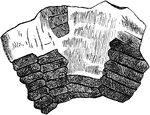
Urchin Fossil
A fossil of Echinothuria floris, a species of sea urchin "having the plates of the shell overlapping…

Hawaiian Rock Urchin
The Hawaiian Rock Urchin (Echinometra oblongata) is a sea urchin, here "with spines in part removed…
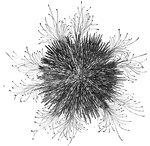
Sea Urchin
Sea urchin: the heavy projections are the spines; the long, slender ones are the tube feet.
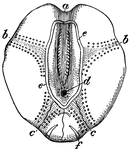
Sea Urchin - View from Above
Amphidotus cordatus or Echinocardium cordatum, commonly called a sea urchin, viewed from above. a, anterior…
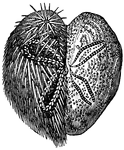
Violet Heart Urchin
Spatangus purpureus. Illustration of the violet heart urchin. One half of the illustration shows the…
